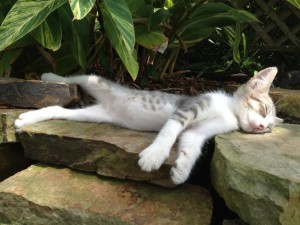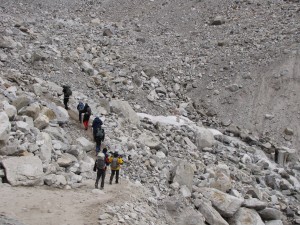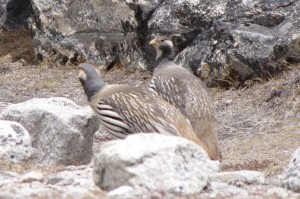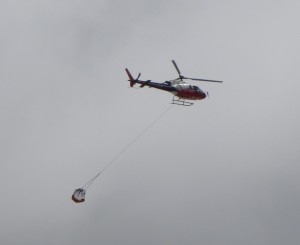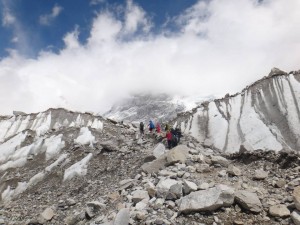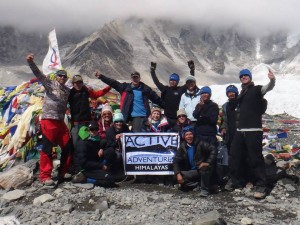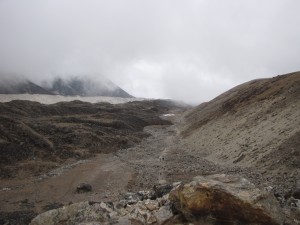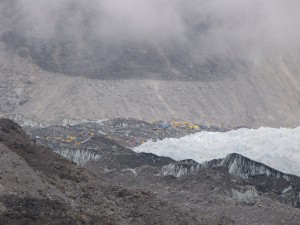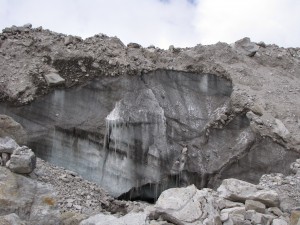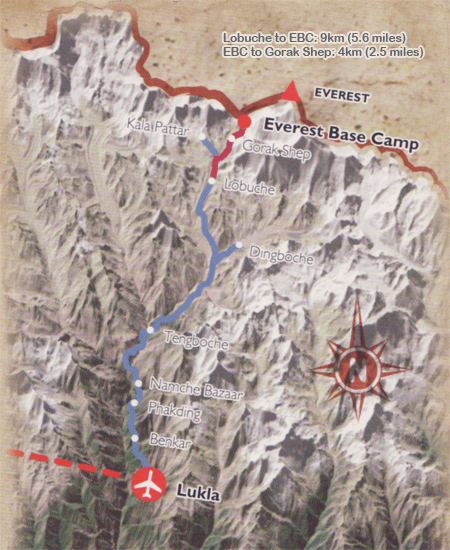 That night was rough. Even with the window open the smell of kerosene was overpowering. I tried to breathe through my buff and felt even more suffocated than breathing straight fumes. Though dragging the sleeping bag outside was tempting, I settled for moving my face as close to the window as possible, imagining the outside air to be somewhat cleaner.
That night was rough. Even with the window open the smell of kerosene was overpowering. I tried to breathe through my buff and felt even more suffocated than breathing straight fumes. Though dragging the sleeping bag outside was tempting, I settled for moving my face as close to the window as possible, imagining the outside air to be somewhat cleaner.
Directly outside would not have been much of an improvement. Once the sun went down smoke from yak dung fires spewed from every lodge and the streets of Lobuche became clouded with it. I learned this the hard way the evening before when I coaxed a few of the others outside briefly before dinner with the promise of clean air, only to get incredulous looks and a bunch of “thanks a lot” remarks as we quickly decided kerosene fumes were preferable and went back inside.
By morning my eyes felt like they were going to pop out of my head. I thought back to all the times I went fishing as a kid, and watched their eyes bulge out when we pulled them from the water. Poor fish… this was terrible. I had finally met my kryptonite on the mountain and it was kerosene fumes.
Little sleep, little air, and fish eyes. Get me out of here. I had just enough ambition to brush my hair but didn’t bother to do anything with it other than pull on the pink hat, and moved much slower than normal packing up. My eyes felt better when we left the building and were back in clean air. Still, the damage had been done and I was drained.
The only other time I could remember being affected by altitude was in a float plane in Canada. I don’t know how high we were, high enough to be flying over glaciers, and planes that small aren’t exactly pressurized. I wished at the time I had toothpicks to hold my eyes open, the views were epic but all my body wanted to do was sleep. The same happened today. Whenever we stopped for water, it was very tempting to curl up on some of the nice cozy rocks for a snooze.
At one stop the porters, who had already been to Gorak Shep, materialized to take some of our daypacks. I was cuddled up with nice soft boulder, sipping water with my eyes half-open, which made me an ideal candidate to give up her pack. I didn’t hesitate. DK came over and ran down a list of symptoms.
” Headache?”
“No.”
” Nausea?”
“No.”
“Tummy bubbles?”
(What? Even in my stupor that one was funny.)
“No. Just tired.”
We finished the trip to Gorak Shep (16,942 ft. / 5,140 m), our home for the night, and had lunch. Then it was on to base camp.
The trail to base camp traversed the top of the Khumbu glacier. For all the rocks and sand, we might not have known we were on a glacier, though at times we could hear the trickle of melt water running underneath. The glacier and valley were enormous. Even without being in a somewhat weakened state from altitude the effect would be humbling.
A glacial moonscape seemed an unlikely place to encounter wildlife, yet here was where we came across some of the only local fauna of our entire trip. A few mystery birds as big as chickens. DK and I looked in his bird book later and decided they were probably Tibetan Snowcocks.
On the way, we noticed a commotion involving a helicopter on a nearby mountain and pulled out our binoculars to have a closer look. It appeared to be a rescue. The helicopter took off with something dangling from its rescue net. I zoomed in as much as the lens would go and snapped a photo as it flew past us back down the valley, not thinking much of it. It wasn’t until later that we found out what happened. I’ll quote this passage from another blog, as it tells the story respectfully:
With the end of the Moro/Steck effort plus a false start due to lack of funding for the Gleb Sokolov and Alexander Kirikov North side climb, the new route climbs were not going well. But it turned worse.
On May 15, Russian Alexi Bolotov fell to his death as he was rappelling from a small shoulder off Nuptse.
Bolotov and his partner Denis Urubko had left Base Camp at 2:00AM. They climbed through the Khumbu Icefall and began climbing one of Nuptse’s rock walls via an easy couloir at angle of 45 degrees. As the sun rose on the Western Cwm, they began a traverse across a ledge where they found some old rope. Using this old line, they began a rappel on a steep 60 foot wall.
Bolotov tied in and put stress on the old rope, as it shifted it brushed against the sharp rock edges and broke sending Bolotov free-falling 1000 feet. Urubko quickly down climbed with a first aid kit only find his partner dead.
A few days later a helicopter picked up his body to return him home to Russia.
The news spread quickly as the 50 year-old Bolotov was well liked and very well-respected. Climbers not only on Everest but on other Himalayan mountains were devastated by the news.
With this tragedy, the final attempt to set a new route on Everest on 2013 was stopped.
Everest 2013: Season Recap: Summits, Records and Fights, Alan Arnette
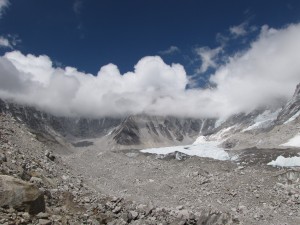
The yellow tents might add some perspective if you didn’t have to use a magnifying glass to find them. Hard to imagine a place more inhospitable and humbling than this.
We hiked up a rise and paused at the top before the trail descended back down to base camp. It might be important for some to note that when I say “base camp,” it could mean two things. There was the actual base camp, also referred to as Tent City, where climbers and their support staff actually stayed. Then, a respectable distance away, was a monument loaded with prayer flags and a sign saying “Everest Base Camp” where most day trekkers like ourselves would end up, take our photos, and leave. Going all the way to Tent City meant a heftier permit fee, and I’m sure most of us would have agreed it wasn’t worth it just to stop in for a few minutes. Actually staying there a night might be another story…
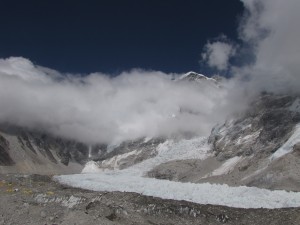
Zoomed in on tent city. Everest is the black peak way in the back. We’ll get better views of her from Kala Patthar.
From the top of the rise, Tent City seemed miles away, and even the shorter walk to the monument was somewhat unappealing due to the inevitable walk back up once all the photos were taken. DK gave us the option to wait where we were, saying we were close enough to call it good, and we could save our energy for Kala Patthar the next day where the views were better. It may have been tempting, but we were a family now and all descended to base camp together.
At the bottom of the hill the trail Nepali-flattened out and we crossed over what was now obviously a glacier with photogenic blue pools and icicles abound. I was looking around considering my next shot while simultaneously trying to keep up when suddenly we were there. DK was laughing and pulled me into a hug. This took me completely by surprise and I couldn’t think of anything to say other than;
“Thank you for getting me here!”
We all made it!! Everest Base Camp. I was 17,598 ft. / 5,364 m high and 7,452 miles / 11,992 km from home.
K-Fed asked DK if we would have gotten any love if we’d stayed behind on the ridge.
“Nope, you’d have had to watch it through binoculars,” he replied cheerfully.
We took our individual and group photos in front of the sign, then sat down and tried to eat the cookies DK handed out. I was so tired. The rock I was sitting on began to feel nice and soft, and I looked back up the hill apprehensively.
Then Sudip, Bibak and the porters started to sing something celebratory in Nepali. DK added rhythm. Next thing I knew I was clapping along, smiling, and feeling fully alive again. Music can be such an amazing healer. It was one of those moments that will probably stick with me forever. The climb back up the glacier, which had seemed so daunting a moment before, now felt perfectly manageable, especially since I had no pack. We went on our way.
Back at Gorak Shep we settled into the common room. I finally got around to asking DK for that article he referred to back in Namche. I don’t remember the author now, she was a woman who questioned the rationality behind 40-80 hour work weeks when so much of the time is unproductive and so much of the money just goes to materialistic pursuits.
DK asked what I thought and I said it was spot on.
“Sometimes hard to be the only weirdo trying to live that way,” I said.
He told me I wasn’t the only one, and gave me a fist bump. True, the only difference was I was still trying and DK was successfully doing.

